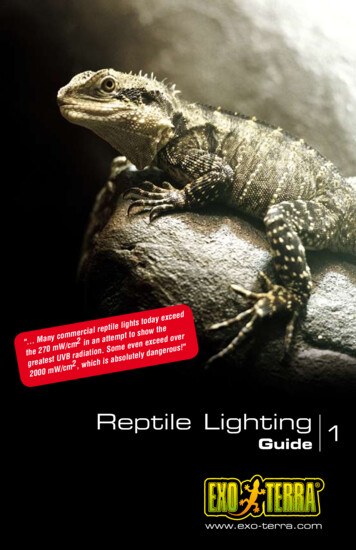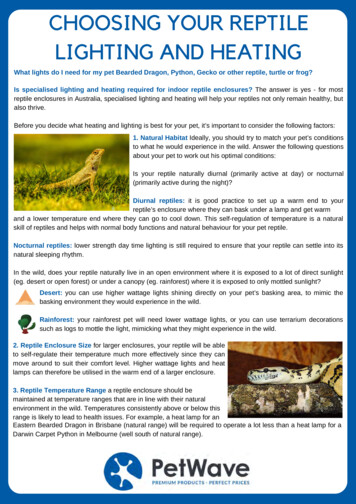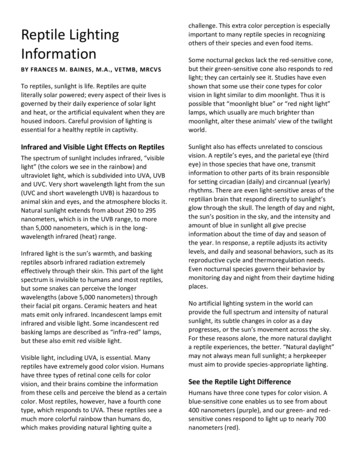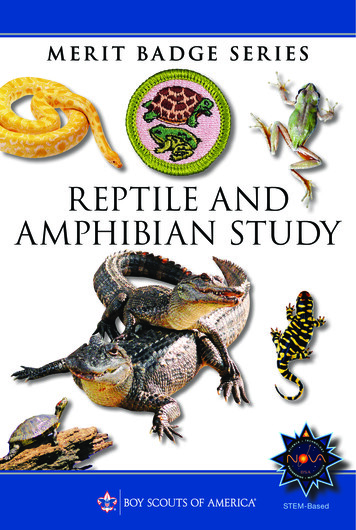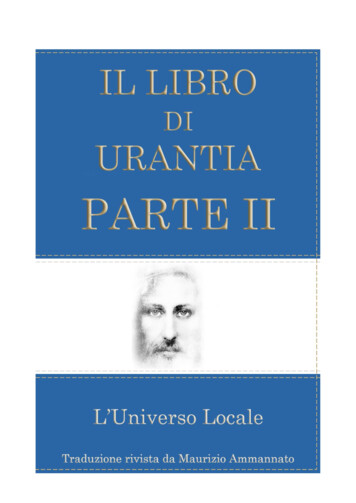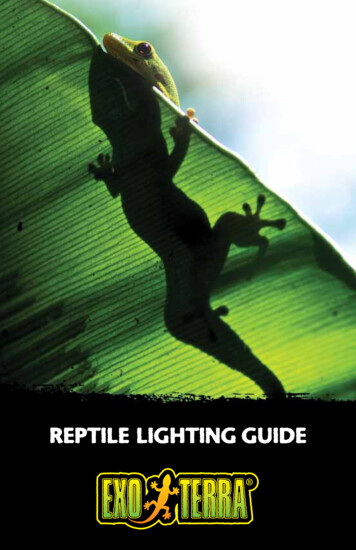
Transcription
Reptile lighting guide
IntroductionThe Exo Terra Reptile Lighting Guide provides information on the various typesof reptile lighting available, complete with an in-depth explanation about lightand the crucial part it plays in successful reptile keeping.Expedition 2011Sri LankaReptile Lighting2IntroductionWhat is Light?4Visible Light4Ultraviolet Light5Infrared Light6The Intensity7Exo Terra Reptile Lighting10All-in-one bulbs16UVB Fluorescent Bulbs22Linear Fluorescent Bulbs26Visual Light Bulbs30Heat & Basking Bulbs34Fixtures46
What is Light?Sunlight arrives at the top of the earth's atmosphere at a power level of about one kilowatt per square meter. It is by this energy that all life-processes on earth are ultimatelydriven. Without the sun's constant energy input our planet would quickly radiate away itsown energy in short order, making all life extinct. Light is referred to as electromagneticradiation because the true nature of light is based on tiny electro-magnetic fields, calledphotons. These photons of light can have many different energy levels or wavelengths,which are expressed in nanometers (nm). The most familiar wavelengths are the visible ones. Every wavelength is represented by a different colour. For example, the Sunappears as yellow because its light is most powerful at the visible wavelength of yellow.However, there are many other wavelengths beyond visible light. All of them together arecalled the electromagnetic spectrum. At the most powerful end of the spectrum are thegamma rays, followed by X-rays, then ultraviolet light, and then visible light which takesup only a tiny fraction of the electromagnetic spectrum and is sandwiched between ultraviolet and infrared light. Infrared light is familiar to us as heat. The spectrum continuesas microwaves and ends in radio waves, the least powerful photons. Of the entire electromagnetic spectrum, only ultraviolet light, visible light and infrared light are important tous at this sible Light400500600700120,000Radiowaves100 billionWavelength (nm)Electromagnetic spectrumVisible LightBesides providing us (and reptiles) with light to see properly, the indication of daytimeand night time (light and dark) is an important function. The visible light spectrum ranges from 390 to 700 nm. The light registered by the eye, and the colour of it, dependson the strength of each wavelength. The Colouring Rendering Index (CRI) expresses theability of a light source to illuminate an object as compared to natural light, with naturalsunlight having a CRI of 100. Nowadays, every artificial light source with a CRI above 95is considered to be a full-spectrum light, since it is able to light-up an object as it wouldappear under natural light and thus receive a certain amount of any wavelength within thevisible spectrum. Closely related is the colour temperature, expressed in Kelvin (K), todefine the colour of the light emitted.Reptile Lighting4What is Light?In describing colour temperatures, a low colour temperature corresponds to a warm or ared-yellow appearance like incandescent lamps, around 2500 Kelvin. Fluorescent lamps,operating at 4500 Kelvin or higher, emit a white-bluish light. In colour temperature, thehigher the Kelvin temperature, the whiter and bluer the light.The standard average temperature for daylight is about 5600K, although it can rangefrom as low as 2000K at sunset, to more than 18000K in overcast or humid conditions.To obtain natural visible light conditions in the terrarium, it is important to choose a lightsource with the highest possible CRI and a colour temperature from around 6000K foroptimal colours in animals and plants. Terrarium plants benefit from certain wavelengthswithin the visible light for photosynthesis. This is a process by which plants use theenergy from light to produce sugar, the "fuel" used by all living things. The conversion oflight into usable energy is associated with the green pigment Chlorophyll. A light sourcewith a high output in the 400-450 nm range promotes plant growth and health.Ultraviolet LightUltraviolet or UV light is a high energy portion of the electromagnetic spectrum, justbeyond visible light.The UV-spectrum is divided into three wavelength groups: UVA - Long wave ultraviolet A, ranges from 320-400 nm and is of significantimportance for reptiles. UVB - Medium wave ultraviolet B, ranges from 290-320 nm and is the mostimportant for reptile purposes UVC - Short wave ultraviolet C, ranges from 180-290 nm and is dangerousto all living organismsIt has been demonstrated that UVA can influence agonistic, reproductive, and signallingbehaviours in reptiles. As reptiles can see into the UVA range (320-400 nm) it will affectthe way they see things. The colour of their food or their bodies will appear different in areptile’s eye then the way we see it if exposed to UVA radiation. Signalling by exposingbody parts (e.g. Anolis sp.) or changing colours (e.g. Chameleon sp.) is common inreptiles, these signals are perceived and also interpreted differently by reptiles if UVAradiation is absent. Failure to provide UVA to diurnal reptiles can cause stress by alteringthe reptile's perception of its surroundings and how it responds to it. This is crucial forbreeding or keeping them around for the length of their natural life span.
UVB is generally defined as the wavelength band from 290-320 nm. In the wild, mostreptiles synthesize their vitamin D3 from the UVB component of sunlight. Vitamin D3is essential for the effective metabolism of dietary calcium in reptiles. UVB reacts withthe precursor of vitamin D, 7-dehydrocholesterol, in the skin to produce provitamin D3.Depending on heat and the aid of a mechanism in the skin, provitamin D3 is convertedinto vitamin D3 itself. The liver and kidneys transform vitamin D3 into its active form, ahormone (1,25, hydroxy-vitamin D) that regulates calcium metabolism.Carnivorous and omnivorous reptiles get a high proportion of their vitamin D3requirement from their food. However, plants do not contain D3 (cholecalciferol), insteadthey contain D2 (ergocalciferol), which is far less efficient in calcium metabolism thanD3. Herbivorous reptiles are therefore far more dependent upon the quantity and qualityof artificial lighting than carnivorous specimens.The earth’s climate is determined by the amount of solar radiation that strikes thesurface. Factors like the sun’s position, the earth’s rotation, geographic location, theozone layer, clouds, air-humidity, elevation, environment, etc. influence the intensity oflight. Also within the microhabitat the light intensity of both visual and non-visual lightvaries, depending on the density of the vegetation or geological conditions. The amountof light falling on a surface is known as the illuminance and is measured in lumens persquare meter or lux. The illuminance of direct sunlight is approximately 100,000 lux, butnormal daylight, which is filtered through a cloudy sky, is between 5,000 and 10,000 lux,while moonlight can be as little as 0.25 lux.If inadequate vitamin D3 is available, the animal will rapidly develop the conditionknown as Metabolic Bone Disease. In this condition, bone density suffers and variousother serious metabolic problems occur. Symptoms include swelling, lethargy, generalweakness, tremors and softening of the shell in turtles and tortoises. Next to a UVB lightsource, adequate levels of calcium must be present in the diet or must be provided bymeans of dietary supplementation. Juvenile reptiles are most at risk, although adultstoo can be affected if maintained in a state of deficiency for a long enough period. Egglaying females are also at great risk, due to the extra demands in calcium necessary foregg production.Ultraviolet radiation is expressed in microwatt per square centimetre (mW/cm2) andvaries tremendously from the poles (low) towards the equator (high). The amount ofUVB radiation received on the equator on a clear day at noon lies around 270 mW/cm2.However, this high amount of radiation decreases as the day passes, in the same way thatit had increased since sunrise, and taking into account that not all days are clear. In thewild, basking activities of most reptiles are limited to early morning and late afternoon.The rest of the day is spent in the shade, either in burrows, crevices or other shadedplaces or at various places in leafy bushes, shrubs or trees. In tropical forests, hometo many types of reptiles and amphibians, only a little direct sun penetrates the forestcanopy and underlying layers to reach the ground.Infrared LightThe UV radiation and light levels to which the reptiles are exposured can vary,depending on a variety of factors:The ectothermic nature of reptiles (being cold-blooded) emphasizes the importanceof infrared radiation (heat) for thermoregulation. The infrared segment of theelectromagnetic spectrum occurs just below or “infra” to red light and is not visible. Itcan, however, be perceived as heat by the skin. The sun produces most of its energyoutput in the infrared segment of the spectrum. The best artificial source of heat fordiurnal reptiles is through an overhead radiant source by means of incandescent lightbulbs, all emitting high amounts of infrared light ( 700 nm).Reptile Lighting6The IntensityWhat is Light?Habitat:Forest and shrub areas provide more shade than plains and deserts. Dense forestshave many gradients of UV radiation, with high levels in the forest canopy to very lowUV-levels on the forest floor. Grasslands and savannahs provide the same gradientsfor smaller species, whereas larger species are more exposed. In deserts there is lessprotection from direct sunlight, and UV levels can even be amplified by reflection. Somemountainous regions have valleys, meaning that sunlight may only penetrate the habitatseveral hours after sunrise, considerably reducing the length of exposure to UV rays.
Activity Patterns:Diurnal (active during daytime) animals receive higher levels of UV than nocturnalspecies for obvious reasons. But even diurnal reptiles do not spend all day in directsunlight. Many species seek cover during the hottest time of the day to avoid overheating. Their basking periods are limited to morning hours and late afternoon. Theseactivity cycles may change in reptiles from seasonal regions. Some nocturnal animalsare exposed to UV radiation as their resting location receives sunlight and some evencome out of their hiding spots toVariation in solar power at the Tropic of Cancerbask in the sun for thermoregulationpurposes.Time of Day:The sun is at its highest in the skyaround noon. At this time, the sun’srays have the least distance to travelthrough the atmosphere and UVB levelsare at their highest. In the earlymorning and late afternoon, the sun’srays pass through the atmosphere atan angle and their intensity is greatlyreduced.Time of Year:The sun’s angle varies with the seasons, causingthe intensity of UV rays to change. UV intensitytends to be highest during the summer months.In the Northern Hemisphere, the sun shinesdirectly overhead at noon at the Tropic of Canceron the first day of summer, at the equator onthe first day of spring and autumn, and directlyoverhead at the Tropic of Capricorn on the firstday of the winter.Latitude:The sun’s rays are strongest at the equator,where the sun is most directly overhead and UVrays must travel the least distance through theatmosphere. Also the ozone is naturally thinnerin the tropics compared to mid- and highlatitudes, so there is less ozone to absorb theNTropic of CancerTropic of CapricornSNTropic of CancerEquatorSNJune 21Tropic of CancerEquatorReptile LightingThe IntensityDec. 21Tropic of CapricornTropic of CapricornS8Mar. 21 / Sept. 21EquatorNAtmosphereRadiationPathlengths troughatmosphere increaseat higher latitudesEquatorSUVB - HotspotsUV radiation as it passes through the atmosphere. At higher latitudes the sun is lowerin the sky, so UV rays must travel a greater distance through ozone-rich portions of theatmosphere and, in turn, expose those latitudes to less UV radiation.Altitude:UV intensity increases with altitudebecause there is less atmosphere toabsorb the sun rays.Weather Conditions:Clouds play a big role in the amountof UV radiation reaching the ground.On a cloudy day, depending on theshape and thickness of the clouds,they can absorb and reflect35-85% of the sun’s radiant energy,and along with the other effects preventall but a negligible amount of radiationSunrays, Reunion Islandfrom reaching the ground. Manyreptiles seek the security of their burrows or hidingplaces during rain, stormy and overcast conditions.Reflection:Some surfaces, such as sand (12%), grass (10%) or water (5%) can reflect muchof the UV radiation that reaches them. Because of this reflection, UV intensity can bedeceptively high even in shaded areas.Ozone:The ozone layer absorbs some of the UV radiation that would otherwise reach theearth’s surface. Ozone levels vary over the year (even throughout the day) and from onegeographical location to another.
Exo Terra ReptileLightingWithout the sun’s energy, all life on earth would cease to exist. It is by the sun’s energy thatall life forces are driven. Without it, our planet would quickly radiate away its own energyin short order, making all life extinct. Although light is much more complex, there are onlythree facets of light that are important for reptile husbandry: ultraviolet light, visible lightand infrared light. In order to create these three biological aspects of sunlight artificially,Exo Terra has developed several specialized lights. Reptiles require appropriate and highquality lighting in order to meet certain different metabolic needs. As it is almost impossibleto accommodate all of these needs in a single light source, a combination of different lightsources is necessary in most cases. The table at right will help you in making the rightlighting choice. Not all reptiles or terrarium animals need the same amount of UVB radiation:nocturnal versus daylight activity, geographical and climatological conditions (ex: rainforestsversus deserts). The distance from the bulb to the animal is equally unray*******************Solar Glo*****************Reptile UVB100************Reptile UVB150*************Reptile UVB200**************Turtle UVB Bulb**********************Reptile UVB100************Reptile UVB150*************Natural Light**********Natural Light ION***************************************Daylight Basking Spot**********Intense Basking Spot****Light SourceAll-in-one BulbsUVB Fluorescent BulbsLinear FluorescentNatural LightVisual Light BulbsReptile VisionHeat & Basking BulbsHalogen Basking SpotDaytime Heat BulbExpedition 2011Sri LankaReptile Lighting10Exo Terra Reptile Lighting*****Night Heat Bulb*****Infrared Basking Spot*******Swamp Basking Spot*********
Over the past few years, more and more research has been done on reptiles and their UVrequirements. Exo Terra has been following the scientific community carefully so we couldimplement new discoveries into our product development process.Unlike 10 years ago, when the knowledge of this subject was minimal, we now know therequirements of most species kept in captivity. In order to provide reptiles the best possiblelighting solution Exo Terra has tweaked all spectrums and added several new bulbs based onrecent research.5.010.0Next to our fluorescent bulbs, we also extended and modified our all-in-one bulb offering:Solar Glo – updated spectrum in the UVB rangeSunray – brand new innovation, the best and most complete reptile bulb yet!A new rating system has been added to all packaging in order to determine what bulbis right for your animals. The rating system refers to a chart on the Exo Terra websiteor Exo Terra Lighting Guide where most common reptiles are listed in relation to theirlighting requirements.Choosing the right UVB bulbCheck the UVB ratingfor your animalWhat is the average distancefrom the bulb to the animal?Look up thecorresponding UVB ratingto choose a suitable bulb123Our new UVB spectrums come with different, easier to understand names;Reptile UVB 100 – tweaked spectrum, formerly Repti Glo 5.0Reptile UVB 150 – tweaked spectrum, formerly Repti Glo 10.0Reptile UVB 200 – brand new spectrum with a very high UVB outputThe numbers 100, 150 & 200 refer to the average UVB output at 4" or 10 cm from thebulb. All our new UVB bulbs have been designed for maximum vitamin D3 photosynthesis,by concentrating the UVB output near the 294 nm within the UV output. At this wavelengthvitamin D3 synthesis is most active! Exo Terra 2012
UVB Rating SystemLIZARDSNAMELATIN NAMEBearded & Rankin’s DragonLeopard GeckoGreen IguanaVeiled ChameleonSpiny-tailed lizardsPanther ChameleonChinese Water DragonAnoles (Green & Bahama)Crested GeckosPogona vitticeps & Pogona henrylawsoniEublepharis maculariusIguana iguanaChamaeleo calyptratusUromastyx spec.Chamaeleo pardalisPhysignathus cocincinusAnolis carolinensis & sagreiRhacodactylus ciliates &Rhacodactylus auriculatusPhelsuma spec.Crotaphytus collarisEremias argutaTakydromus sexlineatusLeiocepahlus spec.AQUATIC TURTLESTrachemys scripta elegansTrachemys scripta scriptaChrysemys pictaSNAKESPython regiusPantherophis guttatusLampropeltis spec.Boa constrictorAMPHIBIANSBombina orientalisCeratophrys spec.Litoria caeruleaPhyllomedusa sauvagiiDendrobatidaeTORTOISESAgrionemys horsfieldiiTestudo GraecaTestudo hermanniGeochelone sulcataDay GeckosCollard LizardSteppe RunnerLong-tailed LizardCurly Tail LizardRed-eared SlidersYellow Bellied SliderPainted TurtleBall PythonCorn SnakeKing & Milk SnakeBoa ConstrictorFire Belly ToadsPacMan FrogWhite’s TreefrogsMonkey Tree FrogsPoison Dart FrogsRussian TortoiseGreek TortoiseHermann’s TortoiseAfrican Spurred TortoiseReptile Lighting14UVB Rating SystemUV RATING
All-in-one bulbsIn nature, the sun produces ultraviolet, visual light and heatradiation all at once. The all-in-one bulbs from Exo Terracombine very high light output and heat radiation with optimallevels of UVA and UVB. These bulbs can be sed as a sole lightsource and are the most natural way to provide lighting andheating to your reptiles while including proper ultravioletradiation for photosynthesis and physiological well-being.SunrayMetal Halide Fixture withBallast & Bulb Metal Halide Fixture with ballast and bulb Stylish design Easy to install and fully adjustable Optimal levels of visible light, heat and UVA and UVB Closely approximates natural sunlight Contributes to the animal’s overall wellbeing Intensifies natural coloration of reptiles Can be safely used on smaller terrariumsThe Exo Terra SunRay Fixture’s stylish looks suits all kinds of terrariums and integrates into any living room.The SunRay Metal Halide Bulb is an all-in-one bulb that combines very high light output and heat radiationwith optimal levels of UVA and UVB. The Exo Terra SunRay delivers a consistent spectrum, which closelymatches that of natural sunlight, contributing to the animal’s overall wellbeing. The combination of the correctwavelength UVB and heat enables the animal to produce it’s own vitamin D3 for proper calcium absorptionand to prevent metabolic diseases (e.g. MBD). The powerful light output and the balanced UV rays stimulatethe appetite, breeding behavior and the overall health of reptiles. The aluminum facetted reflector produces anevenly distributed light beam. Aluminum dissipates heat very effectively, resulting in a longer lifespan and amore stable operation than glass reflectors. The Exo Terra SunRay can be used as a sole light source.PT2315 Sunray Fixture with Ballast & Bulb 35WPT2320 Sunray Fixture with Ballast & Bulb 50WPT2325 Sunray Fixture with Ballast & Bulb 70WTo be operated with metal halide bulbs only.Not suitable for incandescents!Easy to install and fully adjustableReptile Lighting16All-in-one bulbsElectronic Ballast with On/Off Switch
SunrayPT232635WSunray Bulb 35WMetal Halide BulbThe Exo Terra SunRay is an all-in-one bulb that combines very high light output and infrared heatradiation with optimal levels of UVA and UVB. The SunRay is available in lower wattages and can besafely used on smaller terrariums. The Exo Terra SunRay delivers a consistent spectrum, which closelyapproximates that of natural sunlight, contributing to the animal’s overall wellbeing. The combinationof the correct UVB wavelength and heat enables the animal to produce it’s own vitamin D3 for propercalcium absorption and prevents metabolic diseases (e.g. MBD). The powerful light output andbalanced UV rays stimulate appetite and breeding behavior, while improving the physiological healthof reptiles. The aluminum facetted reflector produces an evenly distributed light beam. Aluminumdissipates heat very effectively, resulting in a longer lifespan and more stable operation than glassreflectors. The Exo Terra SunRay can be used as a sole light source. To obtain maximum results andsafety the bulb should be used in conjunction with the Exo Terra SunRay Fixture.Available in 35W, 50W and 70W.PT232750WSunray Bulb 50W70WPT2328Sunray Bulb 70WREPTILE BULB RATING SYSTEM UVB80Reptile VisionHuman Vision60Heat40200280400600Wavelength (nm)8001000Reptile Lighting18All-in-one bulbs 2012 Exo Terra / Hagen Inc.Relative Spectral Power (%)100TemperatureUVAUVBPhotosynth.UVB RatingIlluminanceInchcmµW/cm²µW/cm²Vit. D3IU/MinSee ReptileUVB ChartLUX C 010620002577TemperatureUVAUVBPhotosynth.UVB RatingIlluminanceInchcmµW/cm²µW/cm²Vit. D3IU/MinSee ReptileUVB ChartLUX C 002678DistanceTemperatureUVAUVBPhotosynth.UVB RatingIlluminanceInchcmµW/cm²µW/cm²Vit. D3IU/MinSee ReptileUVB ChartLUX C 0040030764002780Distance
Solar GloPT2192Solar Glo 125WSun Simulating Bulb Stimulates appetite and breedingOptimal levels of UVB, UVA, visual light and heat in one bulb!Provides the benefits of natural sunlightHelps prevent metabolic bone diseaseIncreased UVB penetration distance ( 30 cm / 12”)The Exo Terra Solar Glo is a selfballasted mercury vapor reptile lamp that provides thebenefits of natural sunlight, which is one of the most important aspects in keepingreptiles healthy. The Exo Terra Solar Glo is the choice of professional breeders as itprovides the proper balance of ultraviolet light (including UVA and UVB), visual lightand infrared light (heat), in one easy-to-install bulb. The Exo Terra Solar Glo is afull spectrum light with carefully tuned peaks to ensure appetite, activity, brilliantcolours, and optimal calcium absorption through VitaminD3 production. The Exo Terra Solar Glo is a self-ballastedmercury vapour lamp, which fits into a standard ceramicsocket (No ballast needed). The Exo Terra Solar Glo isavailable in two wattages: 125 W and 160 W.PT2192Solar Glo 125WPT2193Solar Glo 160WPT2193Solar Glo 160W20400600Wavelength (nm)REPTILE BULB RATING SYSTEM UVBReptile VisionHuman VisionHEAT8001000 2012 Exo Terra / Hagen Inc.0280Reptile LightingAll-in-one bulbs806040200280400600Wavelength (nm)REPTILE BULB RATING SYSTEM UVBReptile VisionHuman VisionHEAT800 2012 Exo Terra / Hagen Inc.40EDOVPR MIM RU& CTW PES60NEEDOVPR MIM RU& CTW PES80Relative Spectral Power (%)100NERelative Spectral Power (%)10020125W1000160WTemperatureUVBPhotosynth.UVB RatingIlluminanceµW/cm²Vit. D3IU/MinSee ReptileUVB ChartLUX 36902068002678401002058002577UVBPhotosynth.UVB RatingIlluminanceµW/cm²Vit. D3IU/MinSee ReptileUVB ChartLUX C stance 0028823690258160028824010020612002882
ReptileUVB100The most important feature of a fluorescent bulb is the ability to emit sufficientUVB light (ultraviolet B), a component of sunlight, whereas an incandescent lamponly emits very limited amounts of UVA light. It is impossible to accommodate ahigh visible light emission with a high ultraviolet (UV) output. The more visible lightemitted, the less UV radiation and vice versa. Fluorescent bulbs do not provide sufficient heat. In addition, a separate heat sourcelike a heat or basking bulb is required. It is recommended to combine a Reptile UVBbulb with a the proper visual light output for optimal results.Tropical Terrarium BulbIdeal for all tropical and sub-tropical reptilesOptimal levels of UVBEffective up to 40 cm (15”)Provides necessary UVB rays for optimal calciummetabolism UVA rays stimulate appetite, activity andreproductive behavior Combine with Natural Light or Reptile Vision foroptimal visual light outputThe Exo Terra Reptile UVB100 emits optimal levels ofUVB, similar to that of shady environments such asrain forests or other tropical locations. Reptiles livingin these habitats receive moderate UV radiation due toclimatological conditions (fairly high humidity, changesin weather, etc) that prevent unfiltered sunlight fromreaching the reptile’s basking site. The optimalVitamin D3 yield index ensures vitamin D3photosynthesis to aid calcium absorption andprevent metabolic diseases.13WDistanceUVAPhotoUVB -synth. UVB Rating Illumin.InchµW/cm²µW/cm²cmVit. D3IU/MinUVBPhoto-synth. UVB RatingInch cmµW/cm²µW/cm²Vit. D3IU/MinSee ReptileUVB ChartIllumin.LUX365035106608 20 270452097012 309015934012 30 120201555016 40407424016 40508533020 50305220020 50408422024 60203118024 60203318028 70153116028 70153218032 8051015032 8071116036 9020014036 9031015040 10000014040 100100150100Relative Spectral Power (%)Relative Spectral Power (%)UVA4 10 1000 170 65806040200Wavelength (nm)UVB Fluorescent BulbsLUXDistance25301002226W4 10 630 105 458 20 210Reptile LightingSee ReptileUVB Chart806040200Wavelength (nm)REPTILE BULB RATING SYSTEM UVBReptile VisionHuman VisionheatReptile UVB100PT2186PT218713W26W 2012 Exo Terra / Hagen Inc.Exo Terra’s UVB fluorescent bulbs are classified according to their percentage of UVBoutput. For tropical and sub-tropical reptiles, Exo Terra Reptile UVB100 are perfectlyadequate, provided they are correctly sited, changed regularly, and the number ofhours of exposure is sufficient. 10-12 hours daily has proven a satisfactory exposurelevel for most species. Animals living in deserts, which are areas with high UVBlevels, should be exposed to Exo Terra Reptile UVB150. We recommend the ReptileUVB200 when the distance from the bulb to the animal exceeds 30 cm (12”) orwhen the bulbs are placed above a dense ventilation screen.m 5.0tr u oec GlSp ptiw ReNe errmfoUVB FluorescentBulbs
Desert Terrarium BulbIdeal for all desert dwelling reptilesHigh UVB outputVery high D3 conversionEffective up to 50 cm (20”)Provides necessary UVB rays for optimal calciummetabolism Recommended for terrariums with dense screencovers Combine with Natural Light for optimal visual lightoutputµW/cm²Vit. D3IU/Min26WLUXDistanceUVAUVBPhoto-synth. UVB RatingInch cmµW/cm²µW/cm²Vit. D3IU/MinIllumin.REPTILE BULB RATING SYSTEM Reptile Vision4 10 1150 195 7543408 20 30050106708 20 360602098012 30 15025842012 30 150251549016 409015628016 406010735020 50508422020 50406727024 60304219024 60305222028 70203116028 70204132 8053015032 8010336 9031014036 90540 10010014040 100240200PhotoUVB -synth. UVB Rating Illumin.µW/cm²µW/cm²Vit. D3IU/MinSee ReptileUVB Chart26WLUXDistanceUVAUVBPhoto-synth. UVB RatingInch cmµW/cm²µW/cm²Vit. D3IU/MinSee ReptileUVB ChartIllumin.LUX4 10 750 130 5023504 10 1350 225 1304680204708 20 5509040103012 30 180301027012 30 240402050016 40 12020619016 40 150251529020 509015414020 50 10015925024 60407313024 607010620020028 70305213028 706095180017032 80204211032 8040731601015036 90153111036 9030621500015040 100 102011040 100 2042150HEATReptile UVB150PT2188PT218913W26W1006040200UVB Fluorescent BulbsUVAcm6080Reptile LightingHuman VisionRelative Spectral Power (%)Relative Spectral Power (%)60UVBDistanceInch8 20 3601008013WLUX3070Wavelength (nm)24See ReptileUVB Chart4 10 690 115 45100Relative Spectral Power (%)See ReptileUVB ChartWavelength (nm)100806040200Wavelength (nm)806040200Wavelength (nm)REPTILE BULB RATING SYSTEM UVBReptile VisionHuman VisionHEATReptile UVB200PT2340PT234113W26W 2012 Exo Terra / Hagen Inc.PhotoUVB -synth. UVB Rating Illumin.µW/cm²Relative Spectral Power (%)UVAcmFor reptiles with very high UV requirementsHelps prevent metabolic bone diseaseIdeal for desert set-ups or taller terrariumsVery high D3 Yield IndexIncreased Vitamin D3 photosynthesisMaximizes calcium absorptionEnhanced UVB penetration distanceCombine with Natural Light or Reptile Visionfor optimal visual light output 2012 Exo Terra / Hagen Inc.DistanceInchHigh Output UVB BulbThe Exo Terra Reptile UVB200 emits the ideal UVBspectrum for optimal Vitamin D3 photosynthesis. TheReptile UVB200 bulb is especially designed to simulateconditions for reptiles with very high UV requirements,like diurnal reptiles from desert environments. Theseareas receive direct unfiltered sunlight with high levelsof UVB. The significantly high Vitamin D3yield index results in increased vitamin D3photosynthesis to aid calcium absorptionand prevent metabolic diseases. Theextended UVB penetration makes thisbulb the ideal choice for taller terrariums orterrariums with denser screens.The Exo T
The Exo Terra Reptile Lighting Guide provides information on the various types of reptile lighting available, complete with an in-depth explanation about light and the crucial part it plays in successful reptile keeping. Introduction What is Light? 4 Visible Light 4 Ultraviolet Light 5 Infrared Light 6 The I
